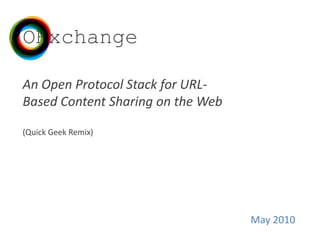OExchange Technical Intro
- 1. OExchangeAn Open Protocol Stack for URL-Based Content Sharing on the Web(Quick Geek Remix)May 2010
- 2. What are we trying to do here? The Web includes an unbounded number of services for sharing, posting, translating, printing, saving for later, and moreGoal #1: Provide a simple, default way for users to send any URL-based content to any service on the webGoal #2: Allow users to personalize their choices, across tools, publishers, and machines
- 3. We Need an Open Protocol SolutionDiscoverPersonalizeExchangeA means to associate preferred services with a userA way to interrogate and discover services that can accept contentA common and simple way to send content, using its URI, to a serviceSupport forcurrently-deployed solutions, future new UX, and verbs beyond “share”Current-generation tools:Focus on sharingTake the form of buttons, rows of chiclets, popup menus, toolbarsPresent too many choices; may not even include what the user wants
- 4. The Basic SolutionA standard endpoint, and a defined HTTP GET flow to send URLs to that endpointAn “Offer” endpoint takes standard arguments (always including URL); has browser control for the transactionAn XRD-based resource that describes the serviceA “Target XRD” document includes the endpoint and related information about the serviceHost-Meta and page-level Link tags make the service discoverableI accept URLs at my Offer endpoint:http://<me>/<whatever>?url=<url>&<etc>That and some info for humans is in my XRD doc:http://<me>/<whatever>/target.xrdYou can discover it from my host-meta or in-page Link tags:rel=“http://oexchange.org/…/related-target”
- 5. The Offer FlowBuild on a deployed browser-based paradigm (add “headless” modes once discovery is adopted)Enforce URLs as primary content indicators (supporting any tagging schemes)Plan for extensibility of verbs (“offer” is the most generic)Content source, in a user’s browserReceiving service (social network, translator, whatever)HTTP GET, usually target=“_blank”http://<service>/<whatever>?url=<url>&<etc>Service-specific UI; browser session up to serviceBrowser session continued
- 6. About TypingWe’re ALWAYS sending URLsURLs which are viewable in a browserURLs which may use any embedded tags (OGP, microformats, etc.)We’re optionally sending extra stuffIframe URLs, images, rich media objectsThis gives us guaranteed compatibility, without ANY negotiationan ability to offer a richer experience for services that support it
- 7. Personalizing ChoicesIf you can send content to any service, and discover new services automatically…Let a user store their preferencesLet all tools, including browsers, access ithttp://<service>http://<service>http://<service>WebFinger lookupPersonal XRD with OExchange linkshttp://<service>/target.xrdhttp://<service>/target.xrdhttp://<service>/target.xrdhttp://<service>/target.xrdmary@example.comOptional local cache
- 8. So What?For ServicesReceive more content, from a greater variety of tools and content providersFor UsersGet the right option at the right time for sharing, saving, blogging, whateverEngage with longer-tail communities of interestFor PublishersGet more of your content out, through more efficient share-throughDon’t have to decide between options
- 9. Taking it ForwardOur strategyCodify the existing model for basic content exchange on the web, while adding a new discovery capabilityAdd new exchange models once this foundation is deployedAdditional exchange modelsWith discovery in place, its easy to standardize more optimized exchange flowsHeadless and return-to-source are primary examplesUser addressing; mutual service negotiation in “Send to Mom” type use-casesLearn more at www.oexchange.org









